
Disclaimer: This is based on our direct experience right now. The situation could change at any time. Starlink’s enforcement of its terms and conditions varies by location. What we experience here in French Polynesia may not be what you experience where you are.
Anyone who claims to know what Starlink will do in the future is just guessing. Nobody knows what will change.
We have no affiliation with Starlink or SpaceX other than that of a subscriber.
The Best Option for Most Cruising Sailors
Roam-Unlimited Service Plan
Fiji Service Address (we use a marina in Fiji as our address)
Opt-in Global Priority Data when offshore (beyond 12nm)
~$84USD/month for unlimited data
~$2USD/GB when offshore using Global Priority data
Sailors in North America should consider the Roam-Unlimited plan with a Mexico or Panama service address. The costs are similar to a Fiji or Tonga service address
Comparison of South Pacific Options
Roam-Unlimited Plan for common service address countries:
Fiji: $191FJD ($84 USD)
Tonga: 201TOP ($83 USD)
NZ: $222NZD ($131 USD)
Australia: $195AUD ($124 USD)
Choosing a Service Address Country
Starlink lets you choose the country in which you base your subscription—the “service address.” Give some consideration to which country you select:
Price
Where Starlink will ship your warranty replacement or accessories
Where you’ll be spending time (helpful if Starlink enforces the “60 Day Rule”)
Some cruisers have friends or family in a country who can receive and re-ship a replacement to them. Their address may be a good choice even though the subscription costs more.
Our Current Configuration
Subscription Plan: Roam - Unlimited: 191FJD (~$84.USD) per month
Service Address: Fiji (Vuda Marina)
Global Priority Data when away from land (more than about 12 miles):
Hardware: Gen2 Dish Kit, Stock OEM Starlink router
Dish Orientation: Automatic (not flat)
Dish Motors: Working (not disabled)
Mount: Generic rail mount from Amazon, mounted on stern rail behind the port helm.
Spares: Gen2 dish kit and router, Spare cable (router to dish)
Current Subscription Plan: Roam - Unlimited
Our current plan is about $84/month for unlimited data when near land (within about 12 miles). We turn on “Global Priority” if we want internet access while away from land. It’s about $2/GB.
Data Consumption
We use 300GB to 400GB of data each month when we are near land and running on “unlimited” data. This with no effort to control or manage the data usage of our various devices. We have two laptops, two iPhones, one iPad, one Smart TV, a PredictWind Datahub, and our Victron Cerbo all connected.
Offshore on a passage, we use about 4GB to 5GB per day provided we have our devices in “low data” mode.
Anticipating Changes to Starlink Subscriptions Plans
Recently, some subscribers on the “Mobile Priority” subscription plans have been forced to switch to new plans.
Roam-Unlimited Plan
If Starlink eliminates the Roam-Unlimited plan or otherwise limits the use of it, we’ll likely be left with one of the “Priority Subscription” plans—Local or Global—which are available now.
Here is what Starlink has to say about “ocean-use” with the Roam-Unlimited plan:
If you are on the Roam Unlimited service plan you will need to opt-in to Global Priority data to use Starlink on international waters.
Our Roam-Unlimited plan has a “Global Priority” data toggle, similar to the old “Mobile Priority” toggle. We hope this means we can continue using the plan as usual.
Starlink may permit Roam Unlimited users to opt-in to purchase Global Priority data. Such permission may be revoked by Starlink in its sole discretion at any time.
Roam-Unlimited and the “60 Day” Rule
According to their terms, Starlink may limit the use of Roam-Unlimited outside of your home country to just 60 days. This has not been enforced in French Polynesia over the past year.
Starlink’s terms of service seem to indicate that this rule is invoked in areas that are sold out or have heavy bandwidth contention from land-based subscribers. That may explain why the term isn’t enforced here in French Polynesia. There are no land-based subscribers here.
Roam Unlimited users in an area with high network congestion where Residential Services are marked as “Sold Out” on the Starlink map for longer than 60 consecutive days, Starlink may, in its sole discretion, (i) require you to pay a fee or upgrade to a different Service plan
If Starlink starts to enforce this rule for the Roam-Unlimited subscription plan in our location, it will effectively put an end to the usability of this plan for cruising sailboats—at least in this area.
Local & Global Priority Plans
The Local and Global Priority plans for business users have two parts: a monthly terminal fee and a per-GB data block fee. The price varies by service location, with Fiji being one of the least expensive.
The “Local Priority” plan may work since we’ll mostly be in and around Fiji this season. However, ocean use is prohibited, so it may not be an option. Or, Starlink may not enforce this provision. Or, they may not enforce that provision in some areas.
We’d pay $324FJD/mo for a 500GB block, which is about $141USD/mo. It’s not as good as our current plan, but still a great deal for high-speed internet on a cruising sailboat.
If “Local Priority” fails, we’d be left with the “Global Priority” plan, incurring a substantial cost increase.
A 500GB block would cost $405FJD/mo plus $1,350FJD/mo, totaling $1,755FJD/mo or about $765USD/mo.
In that case, we’d abandon Fiji and opt for a US-based Global Priority 500GB plan at $650/month.
Conclusion:
We hope to continue using our Roam-Unlimited plan with a Fiji service address, and enabling Global Priority data when offshore.
Otherwise, the Global Priority plan at $650/month is the worst-case scenario. It’s expensive, and a big jump from $84/month. If you want high-speed, low-latency internet in the ocean, it’s your only option.
Confusion Over the Future of the Roam-Unlimited Plan
In September and October of 2024, some subscribers on some plans in some countries got emails from Starlink announcing the “Removal of Priority Data for Roam Service Plans.”
A few weeks later, some of those recipients got another email from Starlink stating they would “…extend the ability to use Mobile Priority opt-in on Roam Unlimited until early 2025…”
And some of us got emails that said nothing about this and simply mentioned, “…you’ll have access to In-Motion Use, International Travel, Coastal Coverage…” and raised our monthly subscription slightly.
All of this confusing communication led many to believe:
Roam plans would be discontinued.
Roam plans would remain, but the option to toggle priority data when offshore would be removed.
None of that came to pass. At least not yet. It might. But it hasn’t. We’ve been happily sailing around French Polynesia using our Fiji-based Roam-Unlimited plan for over a year, toggling on Global Priority Data whenever we are more than 12 miles from land.
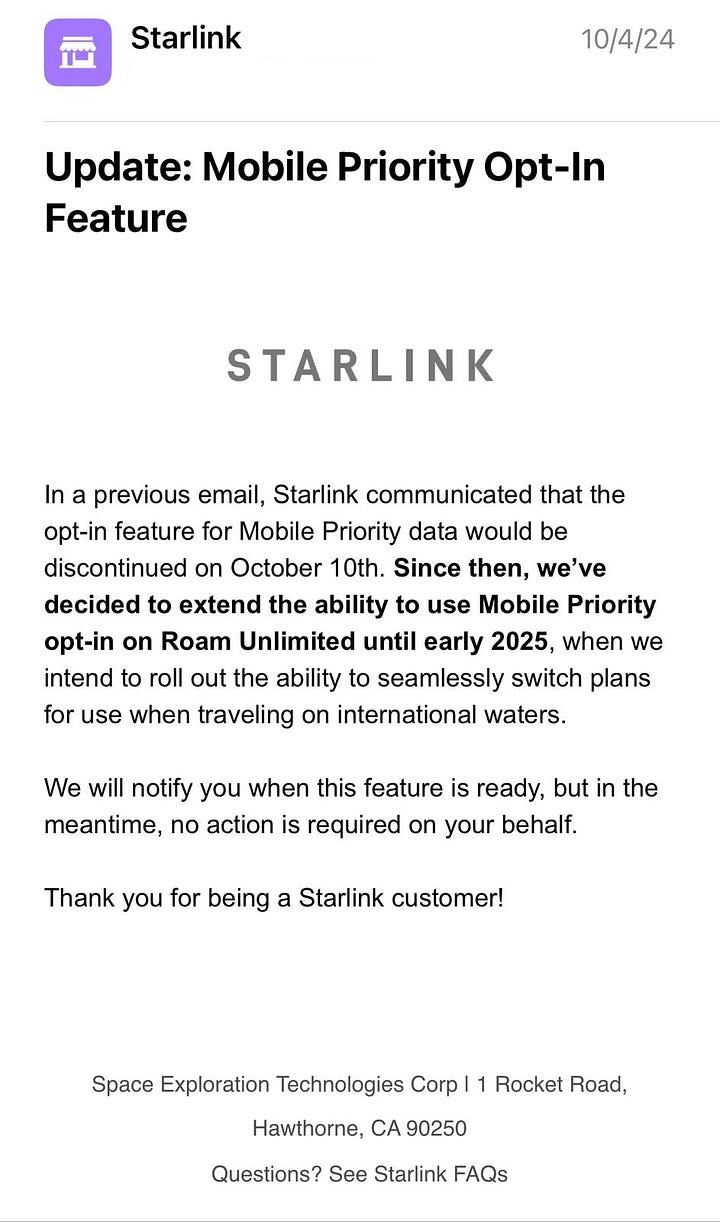
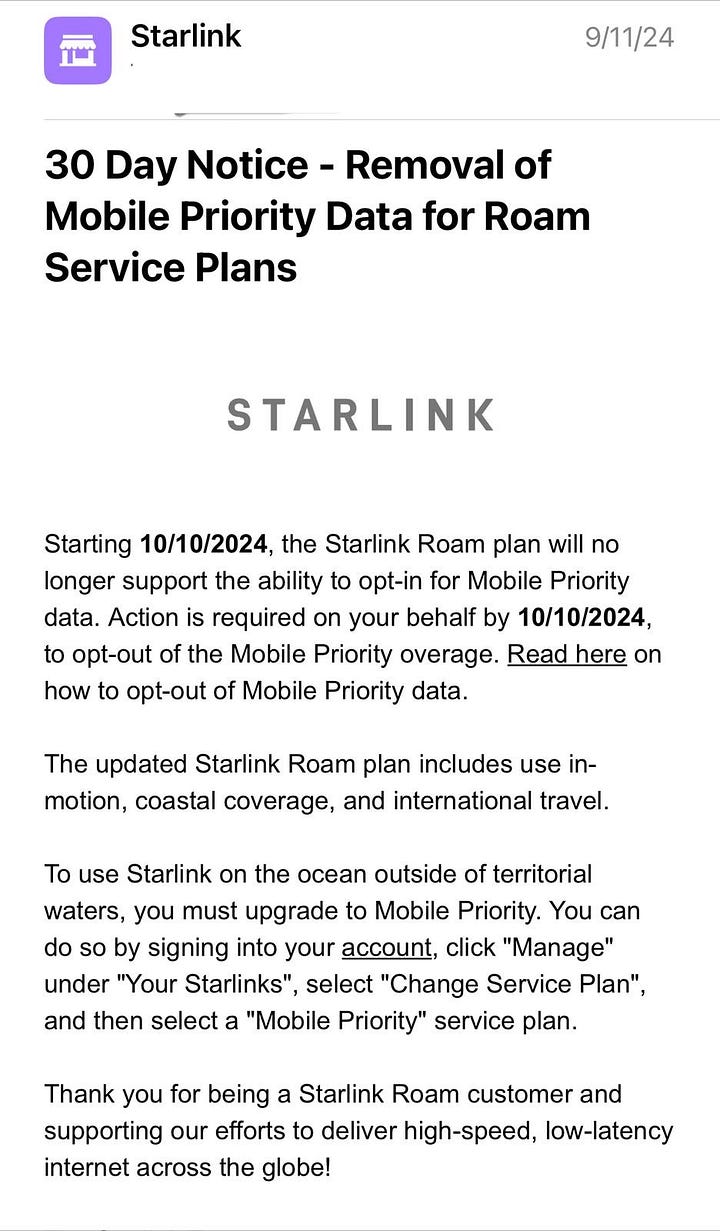
What Happens Offshore?
If you don’t toggle on Global Priority data and you sail 12 miles away from land, you’ll see this:
It means you need to toggle on Global Priority data. On short passages between islands we often don’t bother. A few hours of disconnected-ness isn’t a bad thing.
Gen2 Dish Reliability
We’ve recently had our third Gen2 dish suffer a failed GPS chip. This is not an uncommon problem with these dishes. The symptoms include:
Difficulty maintaining a connection while in motion
Slow to reacquire a connection
“Determining Location” message on the app screen never clears
Debug Data shows “ GPS is not valid”
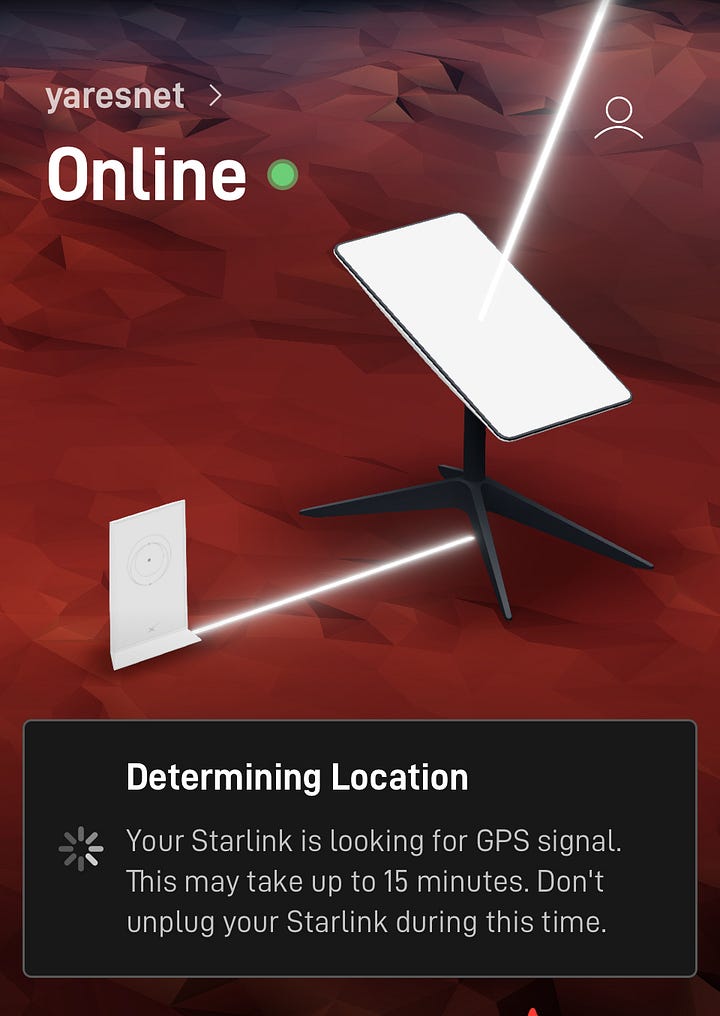
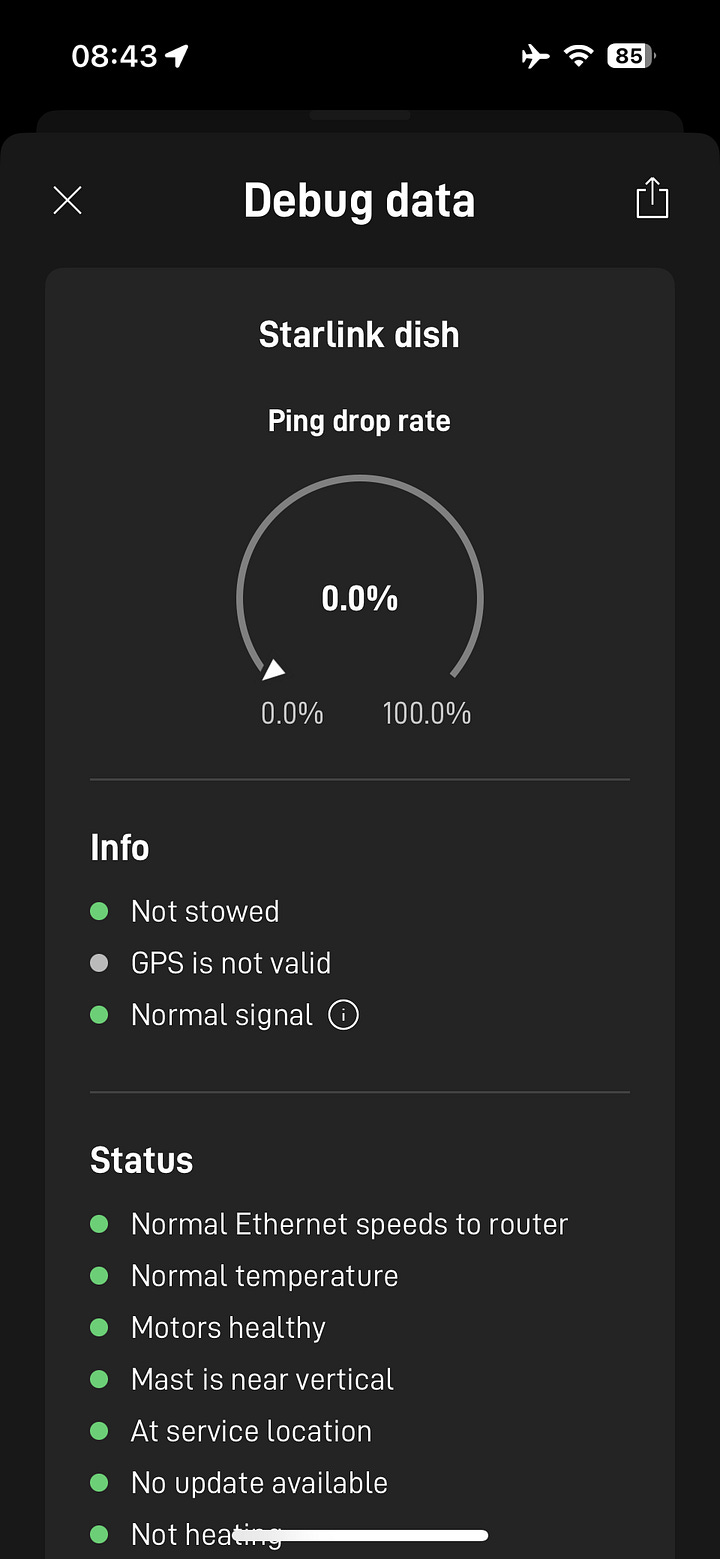
Starlink will replace the dish. It will be shipped to your service address. You can change and update the service address, but you can’t change countries. Our service address is currently in Fiji. When the last dish failed, our warranty replacement was sent to our service address in Fiji. We arranged for DHL to pick it up there and ship it to us in Tahiti. It took about 10 days. The shipping costs were what a new kit would have cost, but they aren’t available in Tahiti, so it was worth it.
For our latest replacement, Starlink is shipping us a V3 dish. They no longer offer Gen2 dishes in our part of the world. We’ll need to work out a new mount for that.
For now, we can limp along with our current Gen2 dish. We’ll swap out our spare Gen2 before we cross to the Cook Islands, Tonga, and Fiji. Hopefully, we will get at least 8 months out of the spare dish (which is how long the Gen2 dishes have been lasting us on average).
Activating a Spare Starlink Dish
We needed to swap out our failed Gen2 dish with a spare. We’ve got a long passage coming up, and the failed dish won’t hold a connection while we are sailing.
It was easy to do. www.starlink.com/activate. The activation site will ask if you want to open a new account or activate your spare dish on your existing account. We chose the latter. And, it lets you choose the subscription plan specific to that dish. We stayed with a Fiji-based Roam-Unlimited plan.
Once the spare dish was up and running for two days, we paused the subscription on the failed dish. That way, we don’t have to pay for two subscriptions. Once we pick up our warranty replacement in Fiji (a Gen3 dish), we’ll decide what to do next.
I needed an internet connection to complete this process. Do it when you have 4G/5G cellular access or before your current dish completely fails (my method here).
For now, we are back in action!

What About The Starlink Mini Dish?
We don’t have any experience with the “mini.” Be skeptical of my comments. I have spoken to three cruising sailors with minis, all of whom are making it work. Those that previously had Gen2 dishes report slightly more incidents of lost connections with their mini dish. One reported it would overheat under an awning (but creating an airspace solved that). For all of them, it is worth the tradeoff to get lower power consumption. 65 watts for the Gen3. 22 watts for the mini. That’s 53 amp hours over 16 hours daily! YMMV.
What is the Deal with Starlink and French Polynesia?
Starlink is not available in French Polynesia. You can’t buy the equipment here, and you can’t subscribe to the service here. You can’t use a French Polynesia service address.
Recent reports suggest you can’t get a Starlink dish kit shipped here anymore (we were able to get a warranty replacement shipped to Tahiti back in September 2024).
Starlink has to negotiate tariff and operating agreements with each regulator in each country in which it sells its equipment and service. It is a herculean legal and business development challenge. It accounts for the different prices and experiences subscribers have with various countries.
French Polynesia has granted the external telecommunications monopoly to the incumbent operator, Office des Postes et Télécommunications (OPT), and its operational subsidiary, Onati. OPT/Onati’s stated strategy is to partner with OneWeb (owned by EutelSat) for satellite-based internet. Availability of a solution from them was scheduled for the first quarter of 2025. That did not happen. No specifics about services and pricing have been announced.
Whether OPT/Onati eventually launches a service and whether it is competitive with Starlink remains to be seen.
There is a case currently before the administrative tribunal in Papeete. This case specifically challenges an administrative decision banning the importation of Starlink antennas into French Polynesia. It is reportedly the first such refusal to be formally adjudicated by the tribunal. The outcome of this case may determine whether sailors and residents can import Starlink dish kits into French Polynesia.
Our Experience
Starlink is a game changer (an overused expression but true in this case). It has allowed me to build and run a global consulting business while sailing across the Pacific and through French Polynesia. We stay in daily contact with our friends and family through phone and video. It enables luxuries like watching movies, popular shows, and the NFL Super Bowl streamed to our computers or television.
For sailing and passaging making, you can’t beat instantaneous access to weather information. It is helpful to access the current satellite loop to determine what you will soon face or how long you’ll be dealing with the current conditions. Before Starlink, the best we got was a single satellite image download that might be half a day old.
It’s not without its drawbacks. It changes the nature of the cruising experience. We are still nearly as “connected” as we were back home. It has largely killed off the HF Radio nets on HAM and SSB as well as the local VHF morning cruiser’s net. Those have been replaced by WhatsApp groups, Facebook groups, and apps like NoForeignLand.
People complain about Starlink changing its plans and terms. This is the nature of iterative development. Try new things. Keep what works. Abandon or change what doesn’t. That approach is what gets you high-speed, low-latency internet in the middle of the ocean at an affordable price (in your cruising lifetime).
People hate change and unpredictability. If you want predictability and stability, you’ll get your cable company (or your mobile carrier). And they don’t have high-speed internet in the middle of the ocean (and likely never will).
Not everyone loves Starlink. We get it. But we wouldn’t go back.


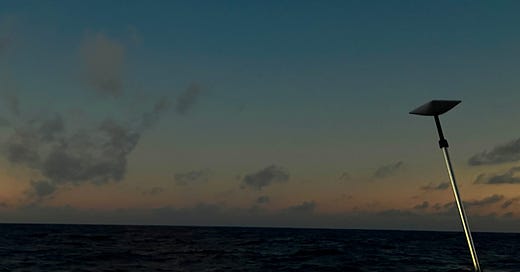


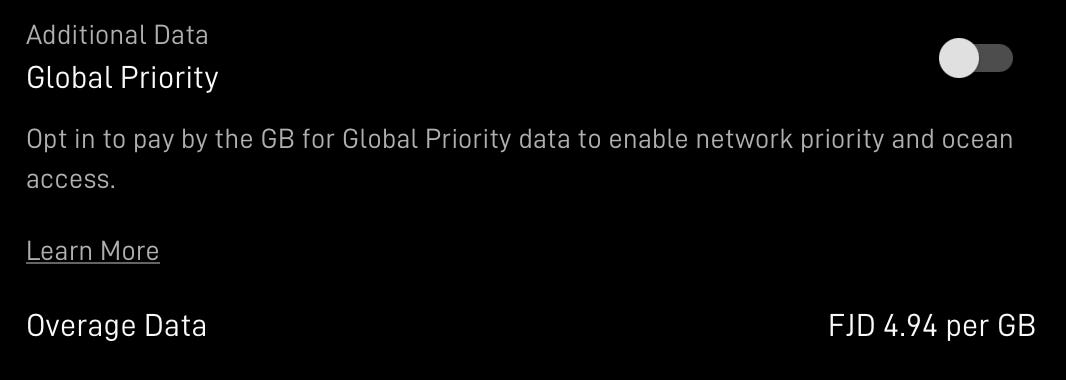
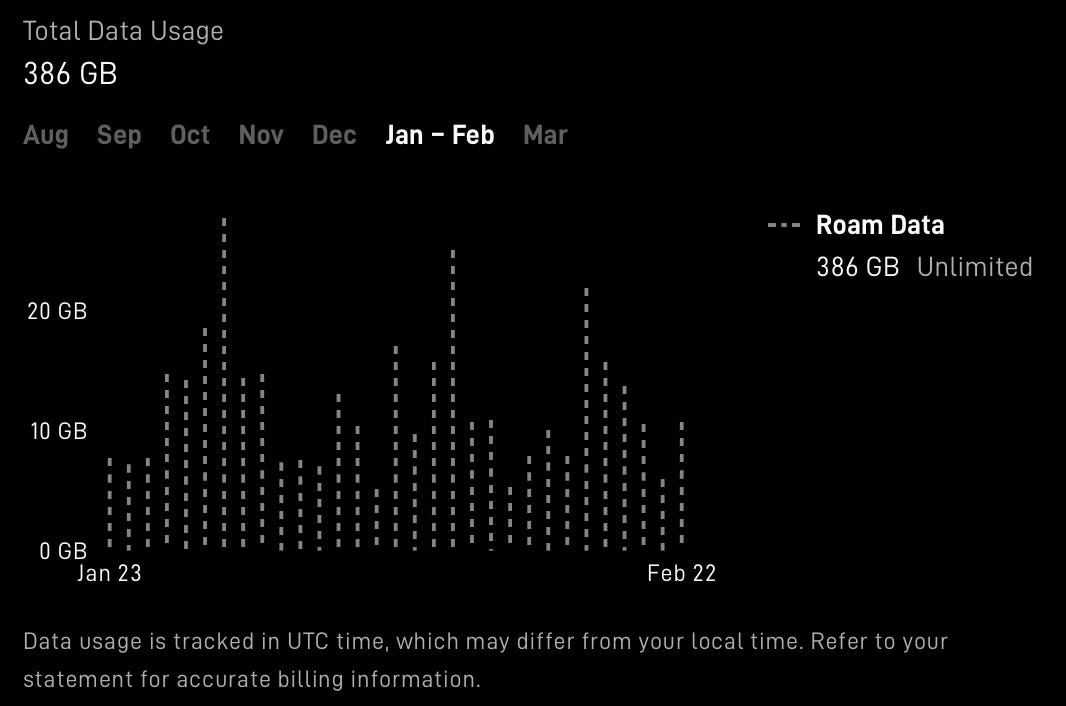
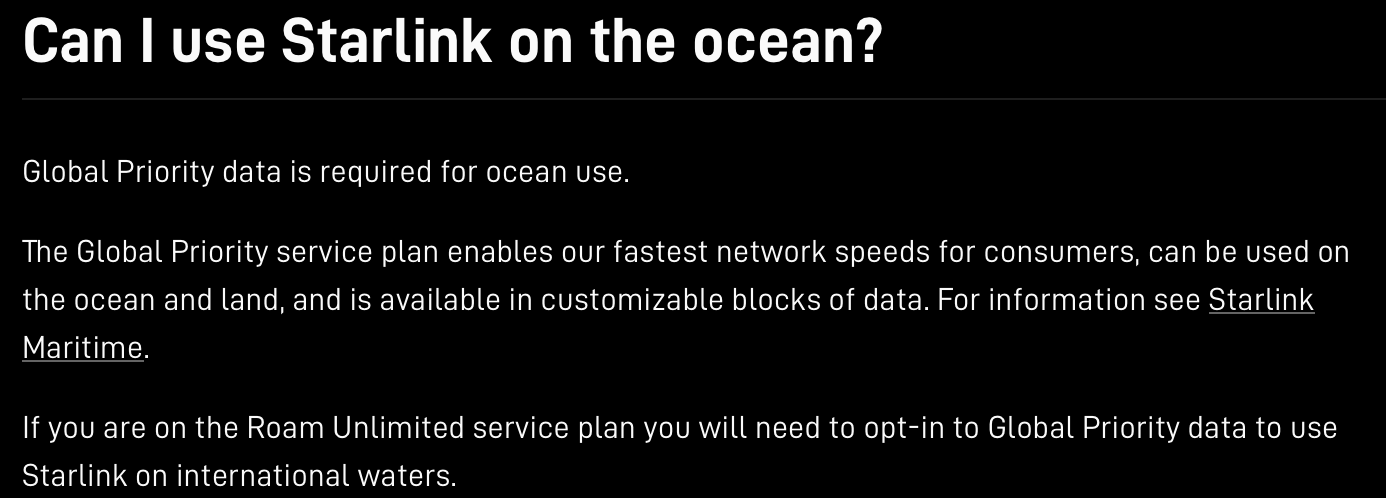


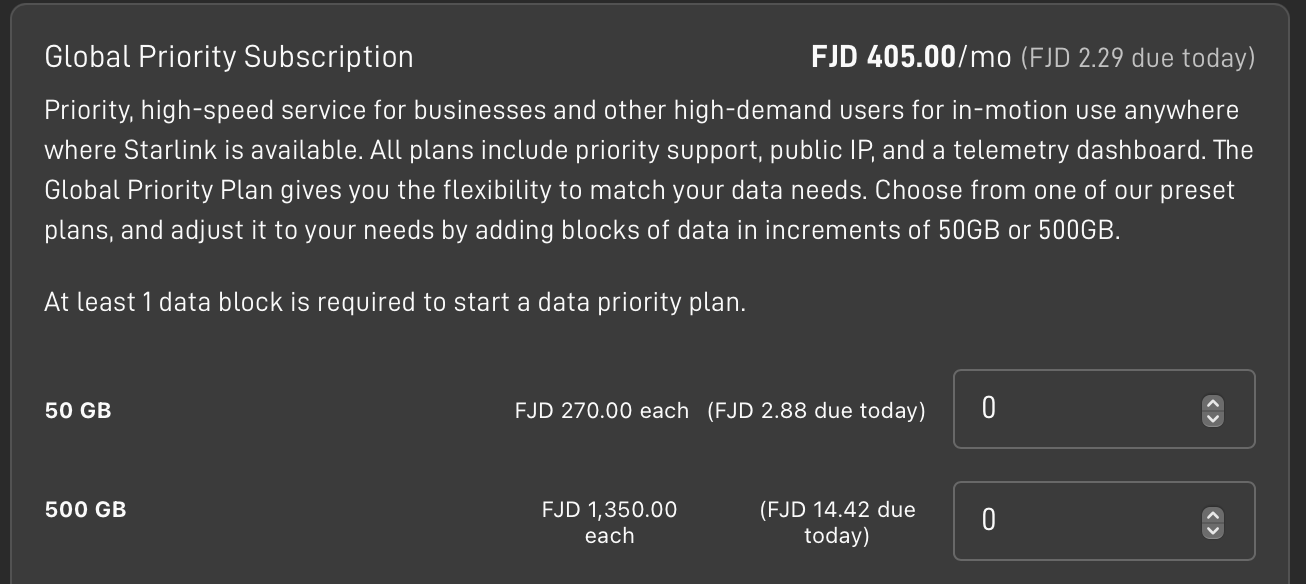



Jim, that's an AMAZING article! Many thanks indeed!
Hey Jim! Thank you for the great article and all of the details! We were in the Republic of the Marshall Islands and had Starlink disconnected as we were outside of our service area (New Zealand) for more than 60 days. We were actually away for almost a year before we got cut off. We ended up changing our service address (from NZ to Fiji) and were reinstated (despite the fact that we were not in Fiji (yet). It took a lot of emails back and forth to get reinstated along with photos of our departure paperwork from RMI.
We are in route to Fiji now and all is working with the Fiji Roam Unlimited plan that is currently switched to Global Priority (as we are underway).
We will use Fiji Roam Unlimited in Fiji until we get to New Zealand where we will switch back to a NZ address. That is of course unless SL forces us to switch to the non-unlimited plans.
We shall see